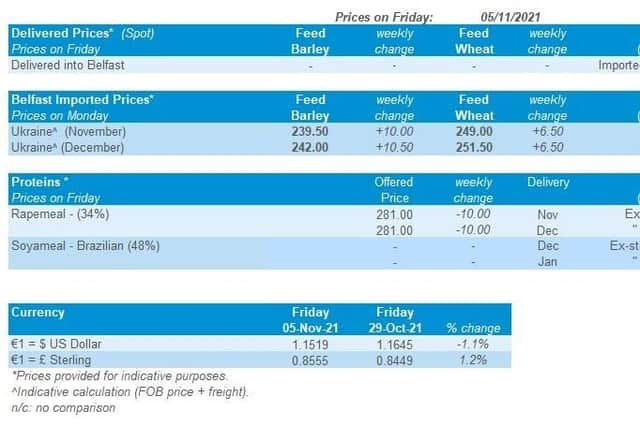Northern Ireland weekly market report


Grains
Wheat - Long-term, sentiment is bullish for wheat markets on tight supply and strong demand. However, profit-taking might mean a trade-off between fundamentals and technical trading in the short-term.
Maize - Maize markets remain reliant on South American crops. La Niña poses a potential risk, although Brazilian conditions are better, the biggest South American maize producer. Strong US ethanol production continues.
Advertisement
Advertisement
Barley - Barley markets continue to track wheat closely. Tight supply and a closing gap between feed wheat and feed barley prices suggest a tight picture.
Global markets - Both UK and US wheat futures (May-22) took a breather last week. UK feed wheat dropped £2.00/t Friday-to-Friday, to close the week at £222.00/t. Within the week a new contract high was reached though, closing Tuesday at £227.10/t. The May-22 US wheat contract also reached a high last week of $297.96/t, but since slipped to close Friday at $287.95/t.
On the other hand, Paris wheat futures experienced gains week-on-week. The Euronext May-22 milling wheat contract gained a further €3.00/t Friday-to-Friday, closing the week at €277.75/t. This said, the contract saw three successive days of losses since Tuesday.
Further profit-taking from traders could take place this week, after recent rallies across global wheat markets. However, a longer-term bullish sentiment remains, and the market awaits tomorrow’s USDA report.
Advertisement
Advertisement
The number of recent tenders from wheat importers suggest demand is still strong into the new calendar year. Also, Morocco have lifted the import tax on soft and durum wheat in a bid to replenish stocks.
In maize news, US ethanol demand remains strong. US figures show near record weekly production remained into week ending 29 October. Maize is a key feedstock into bioethanol production.
Also, the reliance on the Southern hemisphere is still apparent. It is still early, but the La Niña weather phenomenon is posing a risk, particularly in Argentina. Argentine conditions are very dry and although Brazil looks better currently, there is a threat of dryness there too. Combined, the USDA (October report) estimated they would account for 14% of global maize production this marketing year. Another note is that most Brazilian production comes from the Safrinha crop and this won’t be planted until their soyabean harvest starts, which is usually into the new year.
Correction: Last week’s Market Report stated that ‘Russia’s export tax is set to rise again from 16 November to $69.90/t.’ The new tax will actually be effective from 10 November.
Advertisement
Advertisement
UK focus - Last week saw delivered bread wheat prices into the North West at the highest in the history of the AHDB delivered cereals survey. For Dec-21 delivery (North West), the average bread wheat price was £285.00/t. This is the highest since December 2012, when the price for nearby (current +1month) delivery reached £263.00/t (North West).
These record prices are reflective of current global trends and UK tightness. The final results from the AHDB Cereal Quality Survey (CQS) show that just 20% of group 1 samples met a typical group 1 specification (specific weight≥76kg/hl, protein≥13.0%, HFN≥250s). Specific weight is the main issue, averaging 75.4kg/hl. This may mean that more wheat is required to meet flour demand this season.
Feed barley is continuing to track feed wheat. The delivered survey quoted feed barley delivered into East Anglia (Nov-21) at £205.00/t, £13.50/t below feed wheat. Earlier in the season the discount was up to £26.50/t.
Oilseeds - The dials in this report reflect the analyst’s view of the possible direction in markets. The two-week (solid line) and six-month (dashed line) outlooks are based on the best available information at the time of writing. Please note, these views do not constitute trading advice and direction of markets may change due to new information since the time of writing.
Advertisement
Advertisement
Rapeseed - Short-term, inelastic demand will keep prices inflated, but due to current levels, rises in percent terms may be limited. The more bearish outlook for soyabeans may start to weigh on oilseed rape longer-term.
Soyabeans - US harvest, combined with successful plantings in Brazil, are weighing on the soyabean market. Chinese demand is weaker than anticipated, with hog margins decreased. The market is focused on tomorrow’s USDA report (17:00 GMT).
Global markets - Several factors have caused the pressure across the week for Chicago soyabeans (May-22), as prices dropped by 3.2%.
Firstly, total rain over the last seven days in the US-Midwest has been minimal, thus allowing the US soyabean harvest to progress.
Advertisement
Advertisement
Further pressure comes from Brazilian soyabean planting progress. The latest report pegs total planting at 53.5% complete (30 October), up from 36.8% the week before (Conab). Plantings are ahead of this point last year, where they stood at 35.9% complete. If Brazil’s harvest were to start early, the US’ export window requirement could be reduced.
Slower Chinese purchasing softened demand somewhat. Data showed that October imports of soyabeans were 5.11Mt, down 41.2% from October 2020 (General Administration Customs Data).
Malaysian crude palm oil futures (Jan-22) were down 2.9% across the week, tracking losses in the wider oilseed complex. Also according to Reuters, inventories are likely to have rebounded at the end of October due to reduced exports.
Moreover, the USDA’s baseline forecasts, released last Friday, showed the 2022/23 US soyabean area rising year-on-year, to 35.4Mha. This projection is based on analytical models, not farmer surveys.
Advertisement
Advertisement
Rapeseed focus - Paris rapeseed futures (May-22) closed on Friday at €664.00/t, up €2.50/t (0.38%) across the week. The UK delivered price (into Erith, May-22) was quoted at £603.50/t. For harvest-22, delivery into Erith was quoted at £500.00/t.
Sterling weakened (-1.39%) against the Euro week-on-week, helping keep domestic prices supported. Trading closed last Friday at £1 = €1.167.